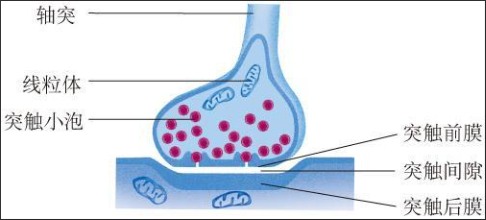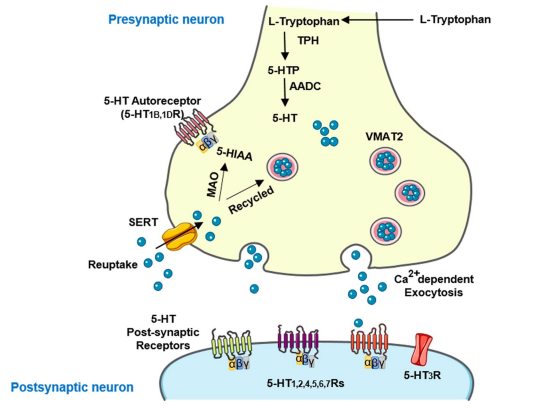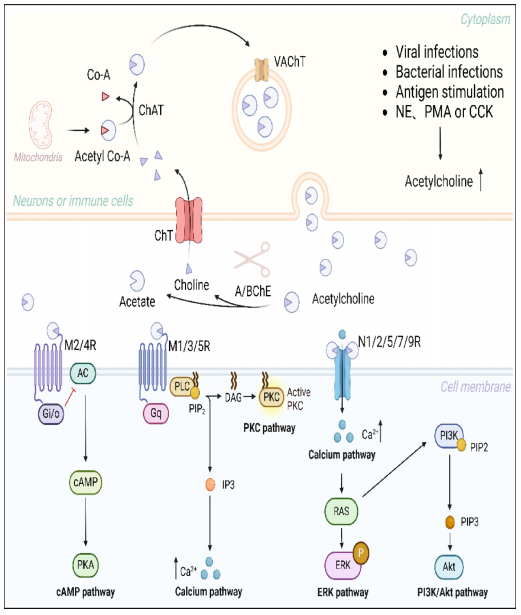Why can some people stay focused for 12 hours straight, while you feel like slacking off after just 30 minutes?
Why do some people fall asleep as soon as their heads hit the pillow, while you stay up late feeling emotional until dawn?
Why do some people have maximum stress resistance, while you lose your temper at the slightest provocation?
The answer may lie with a group of invisible "couriers" in your brain—neurotransmitters!
What Are Neurotransmitters?
Neurotransmitters (NT) are chemical substances that are used for transmitting information between neurons or between neurons and effector cells. Based on their chemical composition, they are mainly classified into choline derivatives, monoamines (noradrenaline, dopamine, and 5-hydroxytryptamine), amino acids, and neuropeptides. NTs are generally synthesized, stored, and released in presynaptic neurons, diffuse across the synaptic cleft to bind with postsynaptic receptors, and finally terminate neural transmission through transport or enzymatic degradation [1]. They regulate all neural activities such as emotion, cognition, movement, and sleep. Let’s get to know 5 important "key messengers"!

Five Major Messengers: What Do They Each Control?
① Dopamine – The "Motivation Generator"
Dopamine (DA), also known as catecholamine or hydroxytyramine, is involved in motor control, regulation of emotional and mood states, reward mechanisms, and other higher cognitive functions [2]. "The motivation to finish a thesis, the infatuation in love, and the pleasure of playing games" are all related to it. Impaired DA transmission is considered a core change in destructive neurological and psychiatric diseases, including Parkinson's disease, schizophrenia, attention deficit hyperactivity disorder (ADHD), and addiction. Studies have shown that dopamine also exerts dual roles in the regulation of the digestive system and inflammation through its receptor network [2,3].
② 5-Hydroxytryptamine – The "Mood Stabilizer"
Hydroxytryptamine (serotonin, 5-HT) is currently regarded as a central regulator of central nervous system function. It modulates emotions, appetite, cognition, pain perception, as well as gastrointestinal motility, cardiovascular homeostasis, platelet aggregation, and immune responses. For example: "The sense of satisfaction after a full meal and the good mood after sunbathing." Imbalanced transmission may lead to depression, anxiety, insomnia, obsessive-compulsive disorder, and other conditions.

Synthesis and metabolism of 5-hydroxytryptamine [4].
③ Noradrenaline – The "Emergency Alarm"
Noradrenaline (NE) is a natural compound in the catecholamine family that acts as both a hormone and a neurotransmitter. It is an endogenous catecholamine synthesized, stored, and released by the sympathetic nervous system, and a weak vasoconstrictor. In clinical emergencies, especially for sudden hypotension caused by septic or hemorrhagic shock, it can quickly raise blood pressure through vasoconstriction, gaining time for organ perfusion. It also controls alertness, attention, and stress responses: "The accelerated heartbeat before an exam and the sudden clarity before a deadline." It is also involved in regulating feeding behavior and satiety. Dysfunction can lead to major depression, anxiety, and other disorders.
④ Epinephrine – The "Fight-or-Flight Switch"
Epinephrine (EPI) is a hormone and neurotransmitter released by the adrenal glands. When the body perceives a threat or danger, the adrenal glands secrete epinephrine, triggering physiological changes such as increased heart rate and elevated blood sugar. "The burst of speed when chased by a dog and the nervousness before a speech" are both related to EPI. Long-term high levels can cause cardiovascular damage and have negative impacts on mental health.
⑤ Acetylcholine – The "Memory Hard Drive"
Acetylcholine (ACh) is a classic neurotransmitter first discovered in the autonomic nervous system. It mainly regulates the parasympathetic nervous system and certain parts of the central nervous system. It controls functions such as learning, memory, muscle contraction, and cognition. Impaired acetylcholine transmission is closely associated with Alzheimer's disease, Parkinson's disease, and other conditions [5].

The synthesis pathway of acetylcholine [10]
How to Detect These "Messengers"?
Traditional detection methods are either too expensive (HPLC-MS/MS) or too complex (electrochemistry). ELISA kits make neurotransmitter detection simple!
Three Major Advantages of ELISA Detection:
- Ultra-sensitive: Can detect trace neurotransmitters below 10 pg/mL
- High specificity: Antibodies specifically capture target molecules to avoid cross-interference
- Easy to operate: 96-well plate for high throughput, results available in 1.5 hours, no expensive equipment required
ReedBiotech Neurotransmitter ELISA Kits are tailor-made for neuroscience, immunology, and psychiatric disease research:
|
Neurotransmitter |
Catalog Number |
Test Samples |
Application Scenarios |
|
Dopamine (DA) |
RE10135 |
Serum, plasma, brain tissue, cerebrospinal fluid, cell supernatant |
Efficacy evaluation of Parkinson's disease models; Addiction research, ADHD |
|
5-Hydroxytryptamine (5-HT) |
RE10166 |
Plasma, serum, intestinal tissue (90% of 5-HT is in the intestines), cell supernatant |
Pathogenesis of depression; Gut-brain axis research, sleep disorders |
|
Noradrenaline (NE) |
RE10132 |
Serum, plasma, brain tissue, cerebrospinal fluid, cell supernatant |
Stress response research; Autonomic nervous system dysfunction |
|
Epinephrine (EPI) |
RE10134 |
Serum, plasma, tissue, cell supernatant |
Anxiety disorders, chronic pain |
|
Acetylcholine (ACh) |
RE10129 |
Serum, plasma, brain tissue, cerebrospinal fluid, cell supernatant |
Alzheimer's disease models; Cognitive impairment research |
Experimental Tips
1.Sample Collection: Neurotransmitters are easy to degradation. Centrifuge at 4°C within 30 minutes after blood collection and store at -80°C.
2.Light-Avoiding Operation: Dopamine, noradrenaline, etc., decompose easily when exposed to light, so full light avoidance is required during the entire process.
3.Technical Support: For first-time experiments, it is recommended to conduct a preliminary experiment first. We provide free experimental design plans.
References
[1] Chu WS, et al. Gene therapy for neurotransmitter-related disorders. J Inherit Metab Dis. 2024;47(1):176-191. doi:10.1002/jimd.12697
[2] Lu X, Liu Q, et al. Research progress on the roles of dopamine and dopamine receptors in digestive system diseases. J Cell Mol Med. 2024;28(7):e18154. doi:10.1111/jcmm.18154
[3] Feng YF, et al. Immunomodulatory Effects of Dopamine in Inflammatory Diseases. Frontiers in Immunology. 2021, 12. 10.3389/fimmu.2021.663102
[4] Pourhamzeh M, et al. The Roles of Serotonin in Neuropsychiatric Disorders. Cell Mol Neurobiol. 2022;42(6):1671-1692. doi:10.1007/s10571-021-01064-9
[5] Świt P, et al. Spectroscopic Determination of Acetylcholine (ACh): A Representative Review. Top Curr Chem (Cham). 2023;381(4):16. Published 2023 May 11. doi:10.1007/s41061-023-00426-9
